
Illustrative Math Alignment: Grade 6 Unit 1
Arithmetic in Base Ten
Lesson 6: Methods for Multiplying Decimals
Use the following Media4Math resources with this Illustrative Math lesson.
| Thumbnail | Title | Description | Curriculum Nodes |
|---|---|---|---|

|
Math Example--Numerical Expressions--Dividing Integers: Example 6 | Math Example--Numerical Expressions--Dividing Integers: Example 6TopicNumerical Expressions DescriptionThis example demonstrates the division of three integers: 48 ÷ 6 ÷ (-4). The solution shows that dividing three integers, two positive and one negative, results in a negative quotient. The calculation is presented step-by-step: 48 ÷ 6 ÷ (-4) = 48 / 6 ÷ (-4) = 8 / -4 = -2. |
Numerical Expressions |

|
Math Example--Numerical Expressions--Dividing Integers: Example 6 | Math Example--Numerical Expressions--Dividing Integers: Example 6TopicNumerical Expressions DescriptionThis example demonstrates the division of three integers: 48 ÷ 6 ÷ (-4). The solution shows that dividing three integers, two positive and one negative, results in a negative quotient. The calculation is presented step-by-step: 48 ÷ 6 ÷ (-4) = 48 / 6 ÷ (-4) = 8 / -4 = -2. |
Numerical Expressions |

|
Math Example--Numerical Expressions--Dividing Integers: Example 6 | Math Example--Numerical Expressions--Dividing Integers: Example 6TopicNumerical Expressions DescriptionThis example demonstrates the division of three integers: 48 ÷ 6 ÷ (-4). The solution shows that dividing three integers, two positive and one negative, results in a negative quotient. The calculation is presented step-by-step: 48 ÷ 6 ÷ (-4) = 48 / 6 ÷ (-4) = 8 / -4 = -2. |
Numerical Expressions |

|
Math Example--Numerical Expressions--Dividing Integers: Example 6 | Math Example--Numerical Expressions--Dividing Integers: Example 6TopicNumerical Expressions DescriptionThis example demonstrates the division of three integers: 48 ÷ 6 ÷ (-4). The solution shows that dividing three integers, two positive and one negative, results in a negative quotient. The calculation is presented step-by-step: 48 ÷ 6 ÷ (-4) = 48 / 6 ÷ (-4) = 8 / -4 = -2. |
Numerical Expressions |

|
Math Example--Numerical Expressions--Dividing Integers: Example 6 | Math Example--Numerical Expressions--Dividing Integers: Example 6TopicNumerical Expressions DescriptionThis example demonstrates the division of three integers: 48 ÷ 6 ÷ (-4). The solution shows that dividing three integers, two positive and one negative, results in a negative quotient. The calculation is presented step-by-step: 48 ÷ 6 ÷ (-4) = 48 / 6 ÷ (-4) = 8 / -4 = -2. |
Numerical Expressions |

|
Math Example--Numerical Expressions--Dividing Integers: Example 6 | Math Example--Numerical Expressions--Dividing Integers: Example 6TopicNumerical Expressions DescriptionThis example demonstrates the division of three integers: 48 ÷ 6 ÷ (-4). The solution shows that dividing three integers, two positive and one negative, results in a negative quotient. The calculation is presented step-by-step: 48 ÷ 6 ÷ (-4) = 48 / 6 ÷ (-4) = 8 / -4 = -2. |
Numerical Expressions |
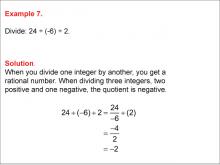
|
Math Example--Numerical Expressions--Dividing Integers: Example 7 | Math Example--Numerical Expressions--Dividing Integers: Example 7TopicNumerical Expressions DescriptionThis example illustrates the division of three integers: 24 ÷ (-6) ÷ 2. The solution demonstrates that dividing three integers, two positive and one negative, results in a negative quotient. The calculation is presented step-by-step: 24 ÷ (-6) ÷ 2 = -4 / 2 = -2. |
Numerical Expressions |

|
Math Example--Numerical Expressions--Dividing Integers: Example 7 | Math Example--Numerical Expressions--Dividing Integers: Example 7TopicNumerical Expressions DescriptionThis example illustrates the division of three integers: 24 ÷ (-6) ÷ 2. The solution demonstrates that dividing three integers, two positive and one negative, results in a negative quotient. The calculation is presented step-by-step: 24 ÷ (-6) ÷ 2 = -4 / 2 = -2. |
Numerical Expressions |

|
Math Example--Numerical Expressions--Dividing Integers: Example 7 | Math Example--Numerical Expressions--Dividing Integers: Example 7TopicNumerical Expressions DescriptionThis example illustrates the division of three integers: 24 ÷ (-6) ÷ 2. The solution demonstrates that dividing three integers, two positive and one negative, results in a negative quotient. The calculation is presented step-by-step: 24 ÷ (-6) ÷ 2 = -4 / 2 = -2. |
Numerical Expressions |

|
Math Example--Numerical Expressions--Dividing Integers: Example 7 | Math Example--Numerical Expressions--Dividing Integers: Example 7TopicNumerical Expressions DescriptionThis example illustrates the division of three integers: 24 ÷ (-6) ÷ 2. The solution demonstrates that dividing three integers, two positive and one negative, results in a negative quotient. The calculation is presented step-by-step: 24 ÷ (-6) ÷ 2 = -4 / 2 = -2. |
Numerical Expressions |

|
Math Example--Numerical Expressions--Dividing Integers: Example 7 | Math Example--Numerical Expressions--Dividing Integers: Example 7TopicNumerical Expressions DescriptionThis example illustrates the division of three integers: 24 ÷ (-6) ÷ 2. The solution demonstrates that dividing three integers, two positive and one negative, results in a negative quotient. The calculation is presented step-by-step: 24 ÷ (-6) ÷ 2 = -4 / 2 = -2. |
Numerical Expressions |

|
Math Example--Numerical Expressions--Dividing Integers: Example 7 | Math Example--Numerical Expressions--Dividing Integers: Example 7TopicNumerical Expressions DescriptionThis example illustrates the division of three integers: 24 ÷ (-6) ÷ 2. The solution demonstrates that dividing three integers, two positive and one negative, results in a negative quotient. The calculation is presented step-by-step: 24 ÷ (-6) ÷ 2 = -4 / 2 = -2. |
Numerical Expressions |

|
Math Example--Numerical Expressions--Dividing Integers: Example 7 | Math Example--Numerical Expressions--Dividing Integers: Example 7TopicNumerical Expressions DescriptionThis example illustrates the division of three integers: 24 ÷ (-6) ÷ 2. The solution demonstrates that dividing three integers, two positive and one negative, results in a negative quotient. The calculation is presented step-by-step: 24 ÷ (-6) ÷ 2 = -4 / 2 = -2. |
Numerical Expressions |

|
Math Example--Numerical Expressions--Dividing Integers: Example 7 | Math Example--Numerical Expressions--Dividing Integers: Example 7TopicNumerical Expressions DescriptionThis example illustrates the division of three integers: 24 ÷ (-6) ÷ 2. The solution demonstrates that dividing three integers, two positive and one negative, results in a negative quotient. The calculation is presented step-by-step: 24 ÷ (-6) ÷ 2 = -4 / 2 = -2. |
Numerical Expressions |
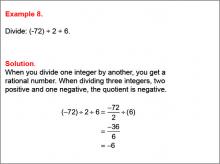
|
Math Example--Numerical Expressions--Dividing Integers: Example 8 | Math Example--Numerical Expressions--Dividing Integers: Example 8TopicNumerical Expressions DescriptionThis example demonstrates the division of three integers: (-72) ÷ 2 ÷ 6. The solution shows that dividing three integers, two positive and one negative, results in a negative quotient. The calculation is presented step-by-step: (-72) ÷ 2 ÷ 6 = -72 / 2 ÷ 6 = -36 / 6 = -6. |
Numerical Expressions |

|
Math Example--Numerical Expressions--Dividing Integers: Example 8 | Math Example--Numerical Expressions--Dividing Integers: Example 8TopicNumerical Expressions DescriptionThis example demonstrates the division of three integers: (-72) ÷ 2 ÷ 6. The solution shows that dividing three integers, two positive and one negative, results in a negative quotient. The calculation is presented step-by-step: (-72) ÷ 2 ÷ 6 = -72 / 2 ÷ 6 = -36 / 6 = -6. |
Numerical Expressions |

|
Math Example--Numerical Expressions--Dividing Integers: Example 8 | Math Example--Numerical Expressions--Dividing Integers: Example 8TopicNumerical Expressions DescriptionThis example demonstrates the division of three integers: (-72) ÷ 2 ÷ 6. The solution shows that dividing three integers, two positive and one negative, results in a negative quotient. The calculation is presented step-by-step: (-72) ÷ 2 ÷ 6 = -72 / 2 ÷ 6 = -36 / 6 = -6. |
Numerical Expressions |

|
Math Example--Numerical Expressions--Dividing Integers: Example 8 | Math Example--Numerical Expressions--Dividing Integers: Example 8TopicNumerical Expressions DescriptionThis example demonstrates the division of three integers: (-72) ÷ 2 ÷ 6. The solution shows that dividing three integers, two positive and one negative, results in a negative quotient. The calculation is presented step-by-step: (-72) ÷ 2 ÷ 6 = -72 / 2 ÷ 6 = -36 / 6 = -6. |
Numerical Expressions |

|
Math Example--Numerical Expressions--Dividing Integers: Example 8 | Math Example--Numerical Expressions--Dividing Integers: Example 8TopicNumerical Expressions DescriptionThis example demonstrates the division of three integers: (-72) ÷ 2 ÷ 6. The solution shows that dividing three integers, two positive and one negative, results in a negative quotient. The calculation is presented step-by-step: (-72) ÷ 2 ÷ 6 = -72 / 2 ÷ 6 = -36 / 6 = -6. |
Numerical Expressions |

|
Math Example--Numerical Expressions--Dividing Integers: Example 8 | Math Example--Numerical Expressions--Dividing Integers: Example 8TopicNumerical Expressions DescriptionThis example demonstrates the division of three integers: (-72) ÷ 2 ÷ 6. The solution shows that dividing three integers, two positive and one negative, results in a negative quotient. The calculation is presented step-by-step: (-72) ÷ 2 ÷ 6 = -72 / 2 ÷ 6 = -36 / 6 = -6. |
Numerical Expressions |

|
Math Example--Numerical Expressions--Dividing Integers: Example 8 | Math Example--Numerical Expressions--Dividing Integers: Example 8TopicNumerical Expressions DescriptionThis example demonstrates the division of three integers: (-72) ÷ 2 ÷ 6. The solution shows that dividing three integers, two positive and one negative, results in a negative quotient. The calculation is presented step-by-step: (-72) ÷ 2 ÷ 6 = -72 / 2 ÷ 6 = -36 / 6 = -6. |
Numerical Expressions |

|
Math Example--Numerical Expressions--Dividing Integers: Example 8 | Math Example--Numerical Expressions--Dividing Integers: Example 8TopicNumerical Expressions DescriptionThis example demonstrates the division of three integers: (-72) ÷ 2 ÷ 6. The solution shows that dividing three integers, two positive and one negative, results in a negative quotient. The calculation is presented step-by-step: (-72) ÷ 2 ÷ 6 = -72 / 2 ÷ 6 = -36 / 6 = -6. |
Numerical Expressions |
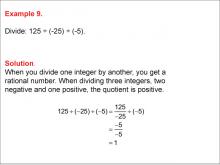
|
Math Example--Numerical Expressions--Dividing Integers: Example 9 | Math Example--Numerical Expressions--Dividing Integers: Example 9TopicNumerical Expressions DescriptionThis example illustrates the division of three integers: 125 ÷ (-25) ÷ (-5). The solution demonstrates that dividing three integers, two negative and one positive, results in a positive quotient. The calculation is presented step-by-step: 125 ÷ (-25) ÷ (-5) = -5 / -5 = 1. |
Numerical Expressions |

|
Math Example--Numerical Expressions--Dividing Integers: Example 9 | Math Example--Numerical Expressions--Dividing Integers: Example 9TopicNumerical Expressions DescriptionThis example illustrates the division of three integers: 125 ÷ (-25) ÷ (-5). The solution demonstrates that dividing three integers, two negative and one positive, results in a positive quotient. The calculation is presented step-by-step: 125 ÷ (-25) ÷ (-5) = -5 / -5 = 1. |
Numerical Expressions |

|
Math Example--Numerical Expressions--Dividing Integers: Example 9 | Math Example--Numerical Expressions--Dividing Integers: Example 9TopicNumerical Expressions DescriptionThis example illustrates the division of three integers: 125 ÷ (-25) ÷ (-5). The solution demonstrates that dividing three integers, two negative and one positive, results in a positive quotient. The calculation is presented step-by-step: 125 ÷ (-25) ÷ (-5) = -5 / -5 = 1. |
Numerical Expressions |

|
Math Example--Numerical Expressions--Dividing Integers: Example 9 | Math Example--Numerical Expressions--Dividing Integers: Example 9TopicNumerical Expressions DescriptionThis example illustrates the division of three integers: 125 ÷ (-25) ÷ (-5). The solution demonstrates that dividing three integers, two negative and one positive, results in a positive quotient. The calculation is presented step-by-step: 125 ÷ (-25) ÷ (-5) = -5 / -5 = 1. |
Numerical Expressions |

|
Math Example--Numerical Expressions--Dividing Integers: Example 9 | Math Example--Numerical Expressions--Dividing Integers: Example 9TopicNumerical Expressions DescriptionThis example illustrates the division of three integers: 125 ÷ (-25) ÷ (-5). The solution demonstrates that dividing three integers, two negative and one positive, results in a positive quotient. The calculation is presented step-by-step: 125 ÷ (-25) ÷ (-5) = -5 / -5 = 1. |
Numerical Expressions |

|
Math Example--Numerical Expressions--Dividing Integers: Example 9 | Math Example--Numerical Expressions--Dividing Integers: Example 9TopicNumerical Expressions DescriptionThis example illustrates the division of three integers: 125 ÷ (-25) ÷ (-5). The solution demonstrates that dividing three integers, two negative and one positive, results in a positive quotient. The calculation is presented step-by-step: 125 ÷ (-25) ÷ (-5) = -5 / -5 = 1. |
Numerical Expressions |

|
Math Example--Numerical Expressions--Dividing Integers: Example 9 | Math Example--Numerical Expressions--Dividing Integers: Example 9TopicNumerical Expressions DescriptionThis example illustrates the division of three integers: 125 ÷ (-25) ÷ (-5). The solution demonstrates that dividing three integers, two negative and one positive, results in a positive quotient. The calculation is presented step-by-step: 125 ÷ (-25) ÷ (-5) = -5 / -5 = 1. |
Numerical Expressions |

|
Math Example--Numerical Expressions--Dividing Integers: Example 9 | Math Example--Numerical Expressions--Dividing Integers: Example 9TopicNumerical Expressions DescriptionThis example illustrates the division of three integers: 125 ÷ (-25) ÷ (-5). The solution demonstrates that dividing three integers, two negative and one positive, results in a positive quotient. The calculation is presented step-by-step: 125 ÷ (-25) ÷ (-5) = -5 / -5 = 1. |
Numerical Expressions |
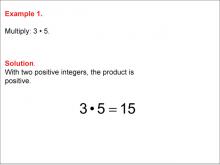
|
Math Example--Numerical Expressions--Multiplying Integers: Example 1 | Math Example--Numerical Expressions--Multiplying Integers: Example 1TopicNumerical Expressions DescriptionExample 1 demonstrates the multiplication of two positive integers: 3 × 5. The solution shows that when multiplying two positive numbers, the result is always positive. In this case, 3 × 5 = 15. Numerical expressions are fundamental in mathematics, representing values through various operations like addition, subtraction, multiplication, and division. This collection of examples illustrates different scenarios of integer multiplication, helping students recognize patterns and develop strategies for solving numerical problems effectively. |
Numerical Expressions |

|
Math Example--Numerical Expressions--Multiplying Integers: Example 1 | Math Example--Numerical Expressions--Multiplying Integers: Example 1TopicNumerical Expressions DescriptionExample 1 demonstrates the multiplication of two positive integers: 3 × 5. The solution shows that when multiplying two positive numbers, the result is always positive. In this case, 3 × 5 = 15. Numerical expressions are fundamental in mathematics, representing values through various operations like addition, subtraction, multiplication, and division. This collection of examples illustrates different scenarios of integer multiplication, helping students recognize patterns and develop strategies for solving numerical problems effectively. |
Numerical Expressions |

|
Math Example--Numerical Expressions--Multiplying Integers: Example 1 | Math Example--Numerical Expressions--Multiplying Integers: Example 1TopicNumerical Expressions DescriptionExample 1 demonstrates the multiplication of two positive integers: 3 × 5. The solution shows that when multiplying two positive numbers, the result is always positive. In this case, 3 × 5 = 15. Numerical expressions are fundamental in mathematics, representing values through various operations like addition, subtraction, multiplication, and division. This collection of examples illustrates different scenarios of integer multiplication, helping students recognize patterns and develop strategies for solving numerical problems effectively. |
Numerical Expressions |

|
Math Example--Numerical Expressions--Multiplying Integers: Example 1 | Math Example--Numerical Expressions--Multiplying Integers: Example 1TopicNumerical Expressions DescriptionExample 1 demonstrates the multiplication of two positive integers: 3 × 5. The solution shows that when multiplying two positive numbers, the result is always positive. In this case, 3 × 5 = 15. Numerical expressions are fundamental in mathematics, representing values through various operations like addition, subtraction, multiplication, and division. This collection of examples illustrates different scenarios of integer multiplication, helping students recognize patterns and develop strategies for solving numerical problems effectively. |
Numerical Expressions |

|
Math Example--Numerical Expressions--Multiplying Integers: Example 1 | Math Example--Numerical Expressions--Multiplying Integers: Example 1TopicNumerical Expressions DescriptionExample 1 demonstrates the multiplication of two positive integers: 3 × 5. The solution shows that when multiplying two positive numbers, the result is always positive. In this case, 3 × 5 = 15. Numerical expressions are fundamental in mathematics, representing values through various operations like addition, subtraction, multiplication, and division. This collection of examples illustrates different scenarios of integer multiplication, helping students recognize patterns and develop strategies for solving numerical problems effectively. |
Numerical Expressions |

|
Math Example--Numerical Expressions--Multiplying Integers: Example 1 | Math Example--Numerical Expressions--Multiplying Integers: Example 1TopicNumerical Expressions DescriptionExample 1 demonstrates the multiplication of two positive integers: 3 × 5. The solution shows that when multiplying two positive numbers, the result is always positive. In this case, 3 × 5 = 15. Numerical expressions are fundamental in mathematics, representing values through various operations like addition, subtraction, multiplication, and division. This collection of examples illustrates different scenarios of integer multiplication, helping students recognize patterns and develop strategies for solving numerical problems effectively. |
Numerical Expressions |

|
Math Example--Numerical Expressions--Multiplying Integers: Example 1 | Math Example--Numerical Expressions--Multiplying Integers: Example 1TopicNumerical Expressions DescriptionExample 1 demonstrates the multiplication of two positive integers: 3 × 5. The solution shows that when multiplying two positive numbers, the result is always positive. In this case, 3 × 5 = 15. Numerical expressions are fundamental in mathematics, representing values through various operations like addition, subtraction, multiplication, and division. This collection of examples illustrates different scenarios of integer multiplication, helping students recognize patterns and develop strategies for solving numerical problems effectively. |
Numerical Expressions |

|
Math Example--Numerical Expressions--Multiplying Integers: Example 1 | Math Example--Numerical Expressions--Multiplying Integers: Example 1TopicNumerical Expressions DescriptionExample 1 demonstrates the multiplication of two positive integers: 3 × 5. The solution shows that when multiplying two positive numbers, the result is always positive. In this case, 3 × 5 = 15. Numerical expressions are fundamental in mathematics, representing values through various operations like addition, subtraction, multiplication, and division. This collection of examples illustrates different scenarios of integer multiplication, helping students recognize patterns and develop strategies for solving numerical problems effectively. |
Numerical Expressions |

|
Math Example--Numerical Expressions--Multiplying Integers: Example 10 | Math Example--Numerical Expressions--Multiplying Integers: Example 10TopicNumerical Expressions DescriptionExample 10 illustrates the multiplication of three integers: -5, 4, and -6. The solution demonstrates that when multiplying three integers with two negative numbers and one positive number, the result is positive. In this case, (-5) × 4 × (-6) = 120. |
Numerical Expressions |

|
Math Example--Numerical Expressions--Multiplying Integers: Example 10 | Math Example--Numerical Expressions--Multiplying Integers: Example 10TopicNumerical Expressions DescriptionExample 10 illustrates the multiplication of three integers: -5, 4, and -6. The solution demonstrates that when multiplying three integers with two negative numbers and one positive number, the result is positive. In this case, (-5) × 4 × (-6) = 120. |
Numerical Expressions |

|
Math Example--Numerical Expressions--Multiplying Integers: Example 10 | Math Example--Numerical Expressions--Multiplying Integers: Example 10TopicNumerical Expressions DescriptionExample 10 illustrates the multiplication of three integers: -5, 4, and -6. The solution demonstrates that when multiplying three integers with two negative numbers and one positive number, the result is positive. In this case, (-5) × 4 × (-6) = 120. |
Numerical Expressions |

|
Math Example--Numerical Expressions--Multiplying Integers: Example 10 | Math Example--Numerical Expressions--Multiplying Integers: Example 10TopicNumerical Expressions DescriptionExample 10 illustrates the multiplication of three integers: -5, 4, and -6. The solution demonstrates that when multiplying three integers with two negative numbers and one positive number, the result is positive. In this case, (-5) × 4 × (-6) = 120. |
Numerical Expressions |

|
Math Example--Numerical Expressions--Multiplying Integers: Example 10 | Math Example--Numerical Expressions--Multiplying Integers: Example 10TopicNumerical Expressions DescriptionExample 10 illustrates the multiplication of three integers: -5, 4, and -6. The solution demonstrates that when multiplying three integers with two negative numbers and one positive number, the result is positive. In this case, (-5) × 4 × (-6) = 120. |
Numerical Expressions |

|
Math Example--Numerical Expressions--Multiplying Integers: Example 10 | Math Example--Numerical Expressions--Multiplying Integers: Example 10TopicNumerical Expressions DescriptionExample 10 illustrates the multiplication of three integers: -5, 4, and -6. The solution demonstrates that when multiplying three integers with two negative numbers and one positive number, the result is positive. In this case, (-5) × 4 × (-6) = 120. |
Numerical Expressions |

|
Math Example--Numerical Expressions--Multiplying Integers: Example 10 | Math Example--Numerical Expressions--Multiplying Integers: Example 10TopicNumerical Expressions DescriptionExample 10 illustrates the multiplication of three integers: -5, 4, and -6. The solution demonstrates that when multiplying three integers with two negative numbers and one positive number, the result is positive. In this case, (-5) × 4 × (-6) = 120. |
Numerical Expressions |

|
Math Example--Numerical Expressions--Multiplying Integers: Example 10 | Math Example--Numerical Expressions--Multiplying Integers: Example 10TopicNumerical Expressions DescriptionExample 10 illustrates the multiplication of three integers: -5, 4, and -6. The solution demonstrates that when multiplying three integers with two negative numbers and one positive number, the result is positive. In this case, (-5) × 4 × (-6) = 120. |
Numerical Expressions |
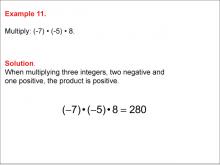
|
Math Example--Numerical Expressions--Multiplying Integers: Example 11 | Math Example--Numerical Expressions--Multiplying Integers: Example 11TopicNumerical Expressions DescriptionExample 11 shows the multiplication of three integers: -7, -5, and 8. The solution demonstrates that when multiplying three integers with two negative numbers and one positive number, the result is positive. In this case, (-7) × (-5) × 8 = 280. |
Numerical Expressions |

|
Math Example--Numerical Expressions--Multiplying Integers: Example 11 | Math Example--Numerical Expressions--Multiplying Integers: Example 11TopicNumerical Expressions DescriptionExample 11 shows the multiplication of three integers: -7, -5, and 8. The solution demonstrates that when multiplying three integers with two negative numbers and one positive number, the result is positive. In this case, (-7) × (-5) × 8 = 280. |
Numerical Expressions |

|
Math Example--Numerical Expressions--Multiplying Integers: Example 11 | Math Example--Numerical Expressions--Multiplying Integers: Example 11TopicNumerical Expressions DescriptionExample 11 shows the multiplication of three integers: -7, -5, and 8. The solution demonstrates that when multiplying three integers with two negative numbers and one positive number, the result is positive. In this case, (-7) × (-5) × 8 = 280. |
Numerical Expressions |

|
Math Example--Numerical Expressions--Multiplying Integers: Example 11 | Math Example--Numerical Expressions--Multiplying Integers: Example 11TopicNumerical Expressions DescriptionExample 11 shows the multiplication of three integers: -7, -5, and 8. The solution demonstrates that when multiplying three integers with two negative numbers and one positive number, the result is positive. In this case, (-7) × (-5) × 8 = 280. |
Numerical Expressions |